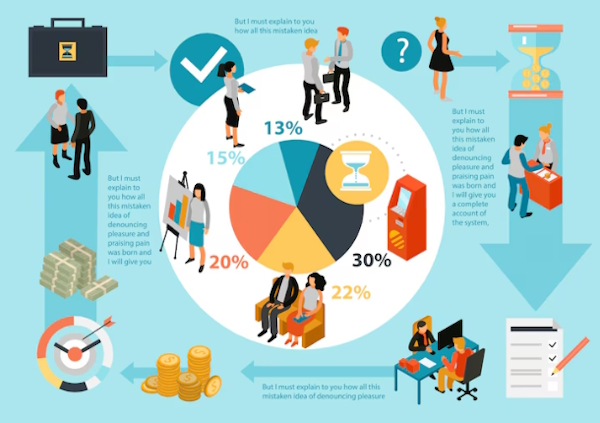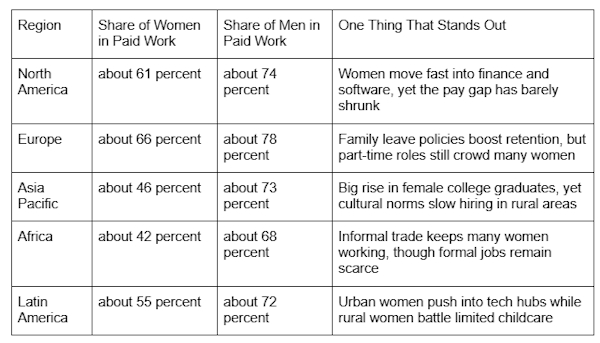Useful Service
 Click here to receive a daily email with new jobs from the 'Useful things to know...' category?
Click here to receive a daily email with new jobs from the 'Useful things to know...' category? (If you are already using this service but have been logged out, simply click here, re-enter your details and we'll email you a login link.)
Contact Information:
Published Content
Email yourself a copy of this job
Click here to see all adverts from Published Content
Click here to receive a daily email with new jobs from the 'Useful things to know...' category?
Employment Data for 2025 by Gender
Description: A look at how constant immersion in games and digital content alters concentration, affects nervousness, and reduces engagement in real life. Read to learn more.
Employment Statistics by Gender in 2025
The world of work in 2025 looks very different from what our parents knew. Digital offices span continents, artificial intelligence shapes job ads, and a growing chorus insists that a fair economy cannot leave half the population standing on the sidelines.

Yet the numbers still tell a mixed story. Women have never been so visible in science labs, boardrooms, and factory floors. Nevertheless, men still claim the larger slice of paid jobs and the top seats in many industries. Below is a closer look at the figures, what drives them, and why they matter for anyone who cares about social justice.
Reading the Numbers: Where We Stand in 2025
Global trends often conceal numerous local nuances, but the headline figures remain steadfast. The International Labour Organization reports that roughly forty-six percent of women of working age held paid jobs in 2024, while about seventy percent of men did the same.
Progress continues, although at a pace that feels glacial to many activists.

Young job seekers show a different twist. Unemployment among young men and young women sits just above twelve percent for both groups (globally).
Equal numbers out of work may sound fair, yet economists point out that young women who stay home to provide unpaid care never appear in those statistics at all.
Automation piles yet another layer onto the puzzle. Recent ILO research warns that women are three times more likely than men to see their jobs replaced by AI, mostly because clerical roles employ more women. While hiring practices are neutral, the technology itself is not.
Why the Female Labour Force Participation Rate Tells the Real Story
Most people first meet the phrase over coffee in an economics lecture; however, it deserves attention far beyond campus walls. The female labor force participation rate captures every woman who is working for pay or actively looking for a job. Think of it as the heartbeat of gender equality in any economy.
When that rate climbs, baby girls grow up seeing their mothers and neighbours earn wages, save money, and negotiate promotions. When it stalls, entire communities miss out on talent and fresh perspectives.
Today, the rate moves along very different tracks. Scandinavian countries flirt with an eighty percent rate, thanks to universal childcare and generous parental leave. Middle-income nations hover near fifty as education gains for women collide with patchy job markets. Low-income states often struggle to reach forty, especially where girls marry early and household chores swallow daylight hours.
Changing that trajectory is not simple, but it pays dividends. The World Bank estimates that closing the gender gap in the workforce could add trillions of dollars to global output over the next decade. More importantly, it rewrites family stories, providing daughters and sons alike with new role models.
Stories Behind the Statistics
Each statistic hides a real person with hopes, obstacles, and everyday choices, so let’s peek at the human forces that push those numbers up or pull them down.

Culture and Expectations
Walk through a bustling street market in Lagos or a busy call center in Manila, and you will hear the same refrain: work is what respectable adults do. Yet the type of work judged respectable for women still varies. In some places, teaching or nursing earns applause, while night shifts at factories invite raised eyebrows. Until communities cheer all kinds of women’s work, hiring managers will quietly copy local bias.
Education as a Launchpad
Better schooling lifts participation faster than any single policy. Girls who finish secondary school are far more likely to land paid jobs, delay early marriage, and climb career ladders. Countries that invested in free secondary education for girls during the last decade now reap higher female employment and smaller household poverty gaps.
Policies that Nudge or Shove
Paid parental leave, subsidized childcare, and strict penalties for wage discrimination all move the needle. Europe’s steady climb in women’s employment owes much to laws that let parents split time at home after a birth. In contrast, nations that offer only short maternity breaks often push new mothers out of the labour force entirely.
Technology’s Double Edge
Remote work opened doors for women balancing family care, yet it also blurred the lines between the office and the kitchen table. Meanwhile, automation targets clerical roles where women cluster. Governments that retrain displaced staff for digital tasks see women bounce back. Those that fail to fund reskilling watch gaps widen.
Leadership and Role Models
A woman in a corner office changes how interns imagine their future. Mentorship programs that pair junior staff with senior women raise promotion rates. Some firms now list management diversity on earnings calls, treating equality as a metric that matters to investors.
The Road Ahead
Analysts who crunch the data offer three main scenarios for the coming decade:
- Business as Usual: Without new policies, the world closes the gender jobs gap at the current crawl. The ILO predicts it could take two centuries to reach parity. Few countries find that timeline acceptable.
- Targeted Interventions: Combining childcare expansion, wage transparency laws, and large-scale reskilling could halve the gap within one generation. Germany’s recent rise in women’s full-time employment after daycare reform suggests this is attainable.
- Tech First, Equity Second: If automation races ahead while social policies lag, women risk losing ground. Roles dominated by men in engineering and data science would grow, while clerical tasks would shrink.
What You Can Do
Even outside government or corporate leadership, individuals help shift the numbers.
- Vote with Your Wallet. Support brands that list clear equality goals.
- Mentor Someone Younger. A short weekly chat can demystify career steps.
- Ask About Pay Practices. Polite questions keep transparency on the agenda.
- Challenge Stereotypes. Praise girls who tinker with code and boys who study nursing.
- Share Reliable Data. Social feeds buzz with opinion. Posting verified statistics keeps debates grounded.
Closing Thoughts
Employment numbers are more than tidy rows in a spreadsheet. They hold dreams of parents who want bright futures for their children and hopes of graduates who refuse to accept outdated ceilings. Every uptick in women’s paid work signals hours freed from unpaid care, salaries funnelled into school fees, and fresh ideas entering decision rooms.
The year 2025 stands as both a milestone and a reminder. We celebrate rising female managers in Nairobi tech hubs and new mothers in Toronto who keep their career momentum.
We also face the unfinished work revealed by the figures above. Change rarely follows a straight line, yet each policy, each community project, and each personal choice can tilt the curve toward fairness.
Keep an eye on that female labour force participation rate. When it rises, society grows richer in every sense that matters.
Be the First to Apply for Jobs Like This
Newsletter
To sign up up for GlosJobs weekly newsletter, please click here.







